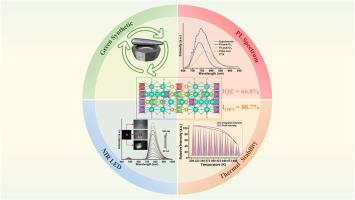A broadband near-infrared phosphor: Solid-state synthesis, two Cr3+ sites occupation and enhanced thermal stability
IF 3.3
3区 物理与天体物理
Q2 OPTICS
引用次数: 0
Abstract
The development of highly efficient, thermally stable Cr3+-activated near-infrared (NIR) phosphors has received significant attention in recent years. However, the synthesis of these phosphors often leads to environmental and safety concerns due to the presence of toxic and corrosive HF. So, we have successfully developed an HF-free synthetic route to synthesize a series of Cs2NaGa1-yScyF6:Cr3+ phosphors. By changing the ratio of Ga3+/Sc3+, the Cs2NaGa0.5Sc0.5F6:0.11Cr3+ (CNGSF:0.11Cr3+) phosphor with the strongest luminescence intensity was obtained. Two sets of NIR emission bands due to two different Cr3+ sites can be observed under blue light excitation. The phosphor exhibits a high internal quantum efficiency (IQE) of 66.7 % and good thermal stability. The luminescence intensity at 423 K maintains 88.7 % of the intensity at room temperature. A NIR light-emitting diode (LED) composed of the CNGSF:0.11Cr3+ phosphor and a blue InGaN chip was used as a NIR light source, and clearly visible photographs of the physical object and veins of the human hand were obtained. These images show that the phosphor has great potential for application in NIR LEDs for night vision and vein imaging.

一种宽带近红外荧光粉:固态合成、占据两个 Cr3+ 位点和增强的热稳定性
近年来,高效、热稳定的 Cr3+ 激活型近红外(NIR)荧光粉的开发备受关注。然而,这些荧光粉的合成往往因有毒和腐蚀性 HF 的存在而引发环境和安全问题。因此,我们成功开发了一条无 HF 的合成路线,合成了一系列 Cs2NaGa1-yScyF6:Cr3+ 荧光粉。通过改变 Ga3+/Sc3+ 的比例,我们得到了发光强度最强的 Cs2NaGa0.5Sc0.5F6:0.11Cr3+ (CNGSF:0.11Cr3+)荧光粉。在蓝光激发下,可以观察到由两个不同的 Cr3+ 位点产生的两组近红外发射带。该荧光粉的内量子效率(IQE)高达 66.7 %,且具有良好的热稳定性。423 K 时的发光强度保持了室温下发光强度的 88.7%。使用由 CNGSF:0.11Cr3+ 荧光粉和蓝色 InGaN 芯片组成的近红外发光二极管 (LED) 作为近红外光源,获得了清晰可见的实物和人手静脉的照片。这些图像表明,该荧光粉在用于夜视和静脉成像的近红外 LED 中具有巨大的应用潜力。
本文章由计算机程序翻译,如有差异,请以英文原文为准。
求助全文
约1分钟内获得全文
求助全文
来源期刊

Journal of Luminescence
物理-光学
CiteScore
6.70
自引率
13.90%
发文量
850
审稿时长
3.8 months
期刊介绍:
The purpose of the Journal of Luminescence is to provide a means of communication between scientists in different disciplines who share a common interest in the electronic excited states of molecular, ionic and covalent systems, whether crystalline, amorphous, or liquid.
We invite original papers and reviews on such subjects as: exciton and polariton dynamics, dynamics of localized excited states, energy and charge transport in ordered and disordered systems, radiative and non-radiative recombination, relaxation processes, vibronic interactions in electronic excited states, photochemistry in condensed systems, excited state resonance, double resonance, spin dynamics, selective excitation spectroscopy, hole burning, coherent processes in excited states, (e.g. coherent optical transients, photon echoes, transient gratings), multiphoton processes, optical bistability, photochromism, and new techniques for the study of excited states. This list is not intended to be exhaustive. Papers in the traditional areas of optical spectroscopy (absorption, MCD, luminescence, Raman scattering) are welcome. Papers on applications (phosphors, scintillators, electro- and cathodo-luminescence, radiography, bioimaging, solar energy, energy conversion, etc.) are also welcome if they present results of scientific, rather than only technological interest. However, papers containing purely theoretical results, not related to phenomena in the excited states, as well as papers using luminescence spectroscopy to perform routine analytical chemistry or biochemistry procedures, are outside the scope of the journal. Some exceptions will be possible at the discretion of the editors.
 求助内容:
求助内容: 应助结果提醒方式:
应助结果提醒方式:


